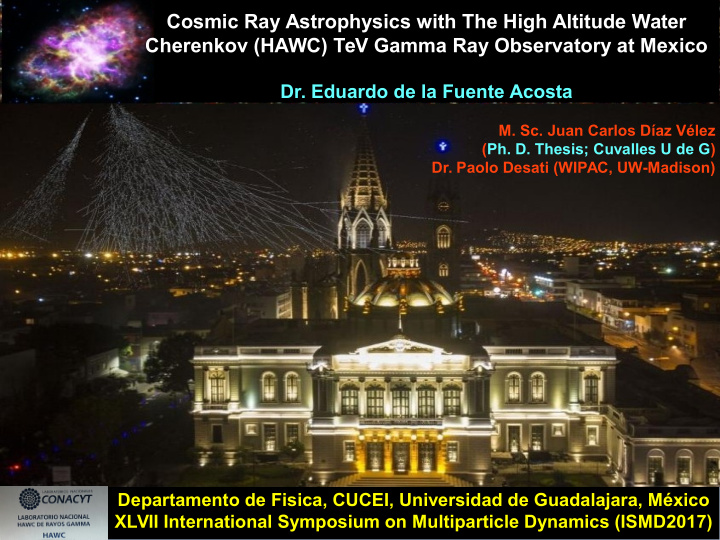



Cosmic Ray Astrophysics with The High Altitude Water Cherenkov (HAWC) TeV Gamma Ray Observatory at Mexico Dr. Eduardo de la Fuente Acosta M. Sc. Juan Carlos Díaz Vélez (Ph. D. Thesis; Cuvalles U de G) Dr. Paolo Desati (WIPAC, UW-Madison) Departamento de Fisica, CUCEI, Universidad de Guadalajara, México XLVII International Symposium on Multiparticle Dynamics (ISMD2017)
High Energy Physics 1.- ACCELERATOR PHYSICS Particle Physics can be divided in: P article Accelerators: 1.- Artificial, and 2.- Natural: THE ENERGY IS THE KEY 2.- ASTROPARTICLES -QUESTIONS TO ANSWER: 1.- ORIGIN (Where are they from?) 2.- IDENTITY (What are they?), 3.- ACCELERATION (How do they get their energy) 3.- NUCLEAR PHYSICS 4.- PROPAGATION (What happend on their way) - HOW: By measuring their 1.- ENERGY SPECTRUM 2.- COMPOSITION 3.- ARRIVAL DIRECTION 3 December 2016 2
MULTIWAVELENGHT ASTRONOMY COSMIC RAYS, GAMMA RAYS, NEUTRINOS Plus Gravitational Wave
Astropartjcles Observatjons (Detectjon) Satellites Water Cherenkov Detectors Air Cherenkov Telescope (IACTs) Plastjc Scintjllators
l First generation of WCD Photo Credit: Michael Schnider (UCSC - HAWC) l
Second generation of WCD
l Near Future Starting (on 2016):
Photo Credit: Michael Schnider (UCSC - HAWC)
Abeysekara et al., HAWC Collaboration The Astrophysical Journal, Volume 796, Issue 2, article id. 108, 11 pp. (2014)
PRELIMINARY Dan Fiorino, UW, USA, Ph. D. Thesis, 2016 JC—Diaz Velez, CUVALLES UdeG+UW, MEX+USA, Ph. D. Thesis, 2017 l Credit:: UW and The HAWC Collaboration
Diaz-Velez Ph. D. Thesis, CUValles, Universidad de Guadalajara; arxiv:1708/03005 (ICRC 2017)
Diaz-Velez Ph. D. Thesis, CUValles, Universidad de Guadalajara; arxiv:1708/03005 (ICRC 2017)
https://arxiv.org/abs/1708.03005
Take on mind that: 1.- For a relative intensity measurement, we need to have a background estimation (where variations exist) 2.- The ammount of cosmic rays arriving to detectors is not uniform (more sensitivity to other directions. Also variations on the atmosphere on time affect detectors sensitivity). https://arxiv.org/abs/1708.03005
Take on mind that: 3.- The latter means we need to make an estimation of the number of cosmic rays that can be detected on every direction considering isotropy and estimate true variations (anisotropy) LIKELIHOOD ANALYSIS TO DO A FIT THROUGH AN ITERATIVE ALGORITHM. Where every iteraction provides a better estimation and so on until converge to a correct result. https://arxiv.org/abs/1708.03005
Take on mind that: 4.- We need also to make a spectral analisis (like fourier transformation) to get an indication of the precence of several signals at different angular scales (as function of space), instead reveals the amplitude of signals at different frequencies (as function of time). Here data combination is more important even that in the multipolar fit, because if we only have partial covering of sky, there is interference at diferent angular scales: Amplitude underestimation or overestimation on the phase at differents scales. 5.- We have anisotripies at large and small scales https://arxiv.org/abs/1708.03005
METHODOLOGY Data map: Reference map: sensitivity of the detector considering an CRs isotropic flux ( iterative maximum likelihood analysis) Compare both, Data and reference map to determine if any "true" anisotropy is observed. This comparasion is done using two maps: Relative Intensity and statiscal signifance map https://arxiv.org/abs/1708.03005
METHODOLOGY Data (D) map: Considering local coordinates of each detected cosmic ray, and the time of each detection (transformation to celestial coordinates): Reference (R) map (Healpix; Gorzky et al. 2005): From data map but considering that the detection time (t) is randomized on a Delta t window: The contribution of the anisotropy is erased, but keeping the angular sensitivity of the detectors and fluctuations from weather variables (Pressure and temperature). https://arxiv.org/abs/1708.03005
Determination of the anisotropy in terms of the relative intensity for each pixel i considering number of events on i (D and R maps) Significanse using T. P. Li and Y. Q Ma method (1983) that consider statistical fluctuations on D and R. No = <Ni> / alpha; alpha = 1 / n https://arxiv.org/abs/1708.03005
https://arxiv.org/abs/1708.03005 Diaz-Velez Ph. D. Thesis, CUValles, Universidad de Guadalajara; arxiv:1708/03005 (ICRC 2017)
The number of cosmic rays expected from this location in asidereal time interval ∆tτ with central value tτ. The likelihood ratio of signal Best method to over null hypothesis in N , A, and I. The relative optimization of the isotropic expectation value for 20 iteration steps recover the total amplitude of the anisotropies at large The progressive loglikelihood scales projected on values of the iteration. Note that the method already converges after about 10 iteration steps. the equatorial plane Diaz-Velez Ph. D. Thesis, CUValles, Universidad de Guadalajara; arxiv:1708/03005 (ICRC 2017)
Multipolar Fit: dipolar and cuadrupolar moment substractions from the data, and study the residuals (Santadner 2013; Ph. D. Thesis, UW-Madison; Smoot and Lubin 1979 ). https://arxiv.org/abs/1708.03005 Diaz-Velez Ph. D. Thesis, CUValles, Universidad de Guadalajara; arxiv:1708/03005 (ICRC 2017)
Relative Intensity after substraction of the multipolar fit. Fit substraction to reveal the caractheristics of small angular scales anisotropies that are embeeded with the larg angular scales anisotropies. Data here is important ti verify independent maps. https://arxiv.org/abs/1708.03005 Diaz-Velez Ph. D. Thesis, CUValles, Universidad de Guadalajara; arxiv:1708/03005 (ICRC 2017)
Diaz-Velez Ph. D. Thesis, CUValles, Universidad de Guadalajara; arxiv:1708/03005 (ICRC 2017)
Muchas Gracias !!! Dr. Eduardo de la Fuente Acosta ( edfuente@gmail.com)
Recommend
More recommend